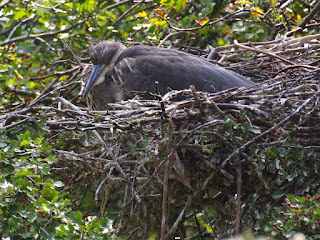The female Kestrel was also back on Buck Hill. We're seeing less of her now, not because she is absent from the park but because she is hunting over a wider area. She has been seen near the Physical Energy statue and in the Flower Walk. The other two Kestrels are seldom seen, but are probably staying in the park.
There are still a few House Martins on Buck Hill.
A pair of Nuthatches came out of the leaf yard to be fed.
There are several pubs called the Magpie and Stump. The most famous one is next to where the public hangings took place outside Newgate Prison, and patrons would gather to watch them on Monday mornings, fortified by a brew called Twopenny Ale.
This first year Black-Headed Gull comes from Poland, as shown by the first letter T on its plastic ring.
As usual, one of the young Grey Herons was on the island ...
... and the other one up in the nest. Virginia reports having seen both of them in the nest yesterday, so at least one of the young ones can fly well enough to get up there.
One of the young Great Crested Grebes from the island pestered his father till he dived, then looked under water to see if he was going to come up with a fish. This time the father was unsuccessful, but shrugged it off.
Some Coots on the Long Water passed the time by chasing each other, and a small fight broke out.
The Coots at the Serpentine outflow have started building a third nest on the edge of the weir. It's a matter of bringing twigs until one of them catches on the edge instead of being swept away, but persistence will win the day. The two chicks can be heard calling from the bottom of the weir. We have seen at least one of them on the lake after climbing up the sloping plank.
A parent brought food for the chicks, and passed it to the other one to take down the ramp.
The three youngest Moorhen chicks in the Italian Garden fountains searched for insects in a patch of water lilies.
The Tufted Duck family on the Long Water is down to three ducklings, but they are now quite large and have a good chance of survival. They cruised past the posts at the Vista.
Two almost fully grown Greylag Geese on the edge of the Serpentine. They differ from adults in a slight difference in their feather patterns, more like scales than bars, in having orange-brown feet rather than pink, and in not having a white bar along the bottom of their folded wings.
Two Egyptian Geese posed symmetrically on the edge of the Round Pond. Thanks to Jon Ferguson for this pleasing picture.
I think this mushroom on the Vista is a Yellow Fieldcap. They are very short lived, coming up in the night and already withered by late morning.












The Grebe chick has razor-sharp underwater eyesight! It can track its father under the water without missing a beat, and tell when and where it will emerge.
ReplyDeleteSo they've embarked on building a third nest by the weir. Doutbless in the Coots' grand scheme of things it will make sense.
I always find signs at British pubs very engaging. The picture of Magpie and Stump deserves being in one!
The Inklings used to meet in a pub they called "Bird and Baby" because the sign depicted an eagle carrying off an infant.
Proper English pub names can be deeply mysterious. 'The Goat and Compasses' is a corruption of the war cry of Cromwell's New Model Army, 'God encompasseth us'. 'The Bag o' Nails' is 'The Bacchanals'. And so on. When you find something completely inexplicable, its's usually the merger of two pubs with unrelated names. However, modern pseudo-pubs created by large catering firms have abused this, and there is a chain of horrid plastic pubs called 'The Slug and Lettuce', and others of a similar kind.
DeleteMy favourite name is that of a pub at Smithfield set up by a discharged soldier who had lost both legs and one arm, and who used his generous disability pension to start his enterprise. He called it 'The Fortunes of War'. In the early 19th century it was a haunt of grave robbers and the hospital staff at the nearby St Bartholomew's Hospital who clandestinely bought the bodies for dissection at anatomy lessons.